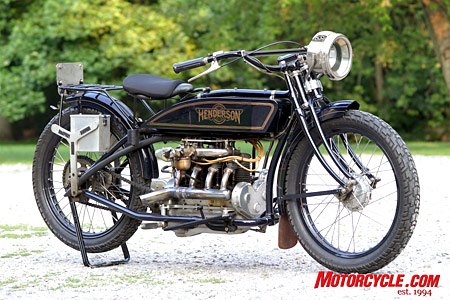1917 Henderson Four Bike Test
The year is 1917, and a young American road racer by the name of Alan Bedell, affectionately known as “the stalwart Californian,” is sat astride a Henderson four-cylinder motorcycle in Los Angeles, California.
As the hands of the clock make their way toward 11.p.m., Bedell waits in quiet contemplation of the journey that lies ahead. With the media describing it as “the most spectacular long-distance motorcycle dash the world has ever known,” Allan T. Bedell is ready to make history as he attempts to break the current transcontinental record, one held by living legend Erwin “Cannonball” Baker. Ahead of him lies 3296 miles of hard, unsupported riding across America. A ride that he predicts will take him nine days.
There is an eager crowd to wave him off, even if the folks back east are scornful of his attempts to wrest the record from the invincible Baker. “Where’d he dream that dope?” the papers read, but Bedell is undeterred and roars out into the night.
Seven days, 16 hours and 16 minutes after his departure, Alan T. Bedell rides triumphantly into New York to claim his record. “Dust covered, with the grime of 12 states on it, the machine looked and sounded as fit as its rider for another battle against father time.”
The stock Henderson had made it. It received just one flat tire, went through three sets of Champion spark plugs and used three Duckworth chains. Using the stock 3.5-gallon gas tank, Bedell added a Mesinger air cushion saddle and a Carlton generator to power the original Coffman spotlight. He suffered just one crash, which somewhat damaged his knee, on a wet road in Indianapolis and averaged 17.89 mph. And, in Ohio on the seventh day of the ride, he was joined by another young racer of the day, Maldwyn Jones. Sadly, the young Californian was not to make or break too many more records, as tragically his young life ended a short time later when he fell victim to the influenza epidemic of the First World War. Alan T. Bedell was just 19 years old.
Jones’ Henderson endurance racer was badly damaged but not destroyed, and it is not clear what happened to it after the failed record attempt. What is known is that Dale Walksler found the bike in 1993 in good un-restored condition having been laid up in storage for many decades. The neglected Henderson was sent out to Steve Huntzinger in California where it spent the next 18 months undergoing a thorough restoration. Inside the engine, the Henderson’s lower ends were supported by three regular bushings coated in Babbitt. Using technology found in old racing airplanes, Huntzinger triple line bored the cases, replacing the bearing inserts and coating them with .010 inch of Babbitt. The original connecting rod bolts were replaced with stronger, modern items and the crankshaft was balanced. During this process it was discovered that the crankcase was warped so it also underwent repair.
Back in 1917 the 61 cubic inch Henderson didn’t have an oil pump and only held one quart of oil, so Huntzinger upgraded the system by chamfering the rods to enhance the oil splash while channeling oil to them. Up above, the cylinders were bored out and a new set of pistons made by J&E. These feature friction-proofed skirts, heat-dispersing ceramic tops and use two compression rings with a three-piece oil ring. In the cylinder head stainless steel valves were chosen, and, to keep the pushrods opening and closing them on time, a third bushing was added in the center of the cam for extra support.
The year 1917 was the first of the three-speed transmission at Henderson motorcycles, and Huntzinger made sure the gearbox was as well treated as the rest of the engine by making new bushings and bearings. To guarantee all the power from the rebuilt engine made it to the gearbox, he also added new clutch plates. Before the bike was re-assembled, the frame was straightened, and replacement rocker studs used in the forks before they were shipped out to be painted Henderson blue.
"I kept thinking to myself the whole time, ‘How did he do it?’ It’s just unbelievable."
During this restoration process, Walksler was making plans to enter the bike into the Great Race, with racing legend Wayne Stansfield at the helm. To this end, a six-inch drum brake was sourced and laced into a set of new clincher rims. These were then fitted with modern Avon Gripster tires to keep them off the ground. The replacement rims were chosen out of necessity, as the originals had a bad safety record in the event of a blow out, the tire usually leaving the rim. As the bike was going to be ridden on public roads, a modern twelve-volt battery was mounted, although with no charging system it would need replacing at regular intervals. Next, a modern headlight bulb was wired into the original carbide lamp and a taillight added.
During this period, after studying old motorcycle magazines, Walksler had become aware of Bedell’s transcontinental record, and knowing the motorcycle they were restoring was the original Maldwyn Jones 24-hour racer, they decided to change plans. The Walksler/Stansfield entry into the Great Race had been denied, so with the 80th anniversary of the cross-country trip approaching, it was a natural decision due to the publicity it could attract.
Departing Los Angeles on June 5, 1997, exactly 80 years to the day, Walksler headed out across country to attempt to break Alan Bedell’s record. Following in the famous racer’s wheel tracks, he did his best to keep to the original route. This was not always possible, as modern roads and bridges now existed where Bedell had crossed rivers in small boats. Covering the distance in six days, one hour and 22 minutes, Walksler rode into New York where he was received by a large crowd for an appearance on Today Show with Al Roker. Quoted as saying, “I kept thinking to myself the whole time, ‘how did he do it?’ It’s just unbelievable,” Walksler had finally broken the record.
The ride itself passed without too much drama, and taking some advice from Bedell’s writing of the day Walksler wore corduroy pants for greater comfort. He also used a bit of modern technology to help his rear end with the addition of a modern gel seat. Over the six days he suffered one blow out, but as testament to the Huntzinger’s work on the 80-year-old Henderson, no mechanical problems.
During the course of the ride, $35,000 was raised in support of American Dirt Track Racing, and a lot of awareness for vintage motorcycles realized. And for those interested, the incredible 1917 Henderson currently resides at the Wheels Through Time museum, where it is regularly ridden. I am sure Maldwyn Jones and Alan Bedell are both smiling.
Related Reading
Royal Enfield Bullet Sixty-5 Riding Impression
Bikes of the Blitzkrieg
2007 Legend of the Motorcycle
Hansen Dam Show and Ride
More by Patrick Barnett
































Comments
Join the conversation